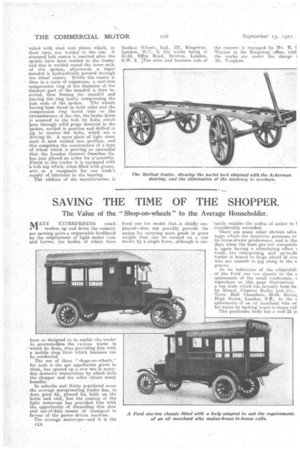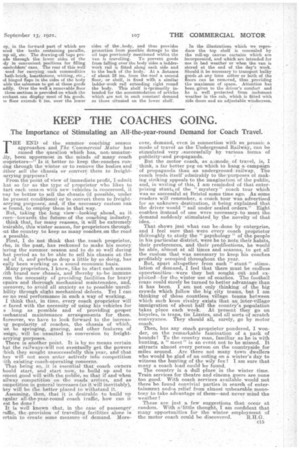SAVING THE TIME OF THE SHOPPER.
Page 10

Page 11

If you've noticed an error in this article please click here to report it so we can fix it.
The Value of the " Shop-on-wheels " to the Average Householder.
MANY ENTERPRISING retail .1.Y1 traders up and down the country are earning quite a respectable livelihood by the employmentof light motor vans and lorries, the bodies of which have
been so designed as to enable the trader to accommodate the various wares in l which he deals, thus providing him with : a mobile shop from which business can be conducted.
The use of these 'shops-on-wheels," for such is the apt appellation given to them, has opened op a new Br i a n everyday domestic transactions by which both the shopper and the seller obtain many benefits.
In suburbs and thinly populated areas the average peregrinating trader has, in days gone by, pinned his faith on the horse and cart, but the coming of the light inotorvan has provided him with the opportunity of discarding this slow and out-of-date means of transport in favour of the power driven machine.
The average motorvan--and it is the C14 Ford one ton model that is chiefly employed—does not possibly provide the means for carrying more goods in gross weight than can be carried on a van drawn by a single horse, although it cer
thinly enables the radius of action to 1 considerably extended.
• There are many other obvious adva tages which the motorvan possesses ov its horse-drawn predecessor, and in the days when the keen pre-was' competith is again having a stimulating effect trade, the enterprising and up-to-cla trader is bound to forge ahead of riva who are content to jog along in the o groove.
As an indication -of the adaptabili of the Ford one ton chassis to the I • quirements of the small tradesman,I reproduce on this page illustrations a van body which has recently been bu: by Messrs. Clement Butler and Co., Town Hall Chambers, 32-34, Boroul High Street, London, S.E., to the r quirernents of an oil merchant who sel his wares by making house-to-house :tall This particular body has a well 21 in
,ep, in the forward part of which are aced the tanks containing paraffin, sip oil, etc. The drawing-off taps proade through the lower sides of the
■ dy in convenient positions for filling ■ useholders cans. The rear of this well used for carrying such commodities bath-brick, hearthstone, whiting, etc., id hinged flaps in the sides of the body able the salesman to get at these goods adily. Over the well a removable floor three sections is provided an which the erchant can display most of his goods. 3e floor extends 6 ins, over the lower sides of the ,body, and thus provides protection from possible damage to the oil taps previously mentioned whilst the van is travelling. To prevent goods from failing over the body sides a ladder. work rail is fitted along each side and to the back of the body... At a, Jistance of about 18 ins. from the roof a second floor, or shelf, is fixed with a similar ladder-work rail extending right round the body. This shelf is 4primarily intended for the accommodation of articles which are not in such constant demand as those situated on the lower shelf. In the illustrations, which we repro flute the top shelf is concealed by the roll-up canvas curtains which are incorporated, and which are intended for nse in bad' weather or when the van is stored at the end of the day's work. Should it be necessary to transport bulky goods at any time either or both of the floors can be removed, thus .providing the maximum of space.. Attention has beert..giVen to the driver's comfort . and he is well protected from inclement weather in the cab, which is fitted with side doors and an adjustable windscreen.
































